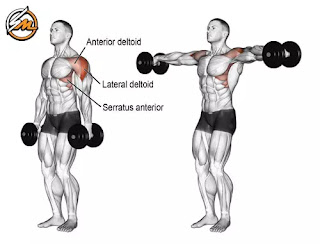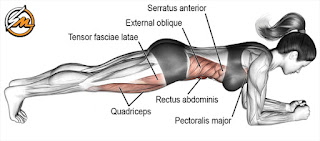Begin with your arms front lifts in a naturally engaged power posture. Lift your arms through shoulder height and towards the ceiling in front of your torso, leading with your thumbs. Use control and intention to drop your arms back to their beginning position once your arms are straightened up by your ears. You'll be able to feel your muscles engage as they get stronger by moving slowly and emphasizing that natural energy tension.
Performing 10 to 20 repetitions over three sets is a good place to start as a basic practice. You can use a dusty can of corn from the back of the cabinet as a makeshift weight for an extra kick in the pants.
2- Lateral raises
Because arm circles and front rises increase strength, it stands to reason that lateral arm raises will do the same. Performing lateral raises with the appropriate amount of force can work your biceps and triceps, much like front raises. However, when lateral arm raises are performed in the opposite direction, they first stimulate the deltoid's medial, or middle, half.
To do lateral lifts, first, get your power stance in order, and then start to work. Bonus points if you use a can from your cabinet or a heavy candle to increase the difficulty. Begin by bringing your arms down by your sides and lifting them to shoulder height with control. As you reverse directions and control the arms back down to your sides, maintain the tension. Performing three sets of 10 to 20 reps at home is a terrific method to add to your already amazing strength.
Get your power stance in order before starting your lateral lifts. To add a little more challenge, grab a can from your closet or a heavy candle. Begin by lowering your arms to your sides and lifting them to shoulder height with control. As you reverse directions and bring your arms back to your sides, maintain the tension. Adding three sets of 10 to 20 reps to your already remarkable strength at home is a terrific method to improve it.
3- Push-ups
The all-powerful push-up. Push-ups are recognized as the queen of all exercises for a reason, whether you love them, hate them, love to hate them, hate to love them, or any variation in between.
When compared to other exercises, push-ups may target the most muscles in one go. The main chest muscles, the pectoralis major and minor, are primarily targeted by push-ups. They also work your core (as you balance in high plank) and your bilateral serratus anterior, which are located beneath your armpits. Push-ups also engage your triceps and deltoids, making it a multi-joint exercise that targets a variety of muscle groups.
A conventional push-up starts with a high plank stance, a firm core, and a straight spine. Bend your elbows and drop your whole body to the ground, then press yourself back up. Because this activity requires a lot of strength to do, it's fortunate that there are so many push-up variations to lessen (or raise) the intensity.
4- Pushup variations
Because regular push-ups might be difficult to perform correctly — especially if you aren't used to them — it's great that there are different ways to incorporate push-ups into your equipment-free upper body workouts.
Push-ups against the wall are a wonderful way to start building your base (per Self). Start your push-ups against a wall rather than on the floor in a plank posture. Push-ups become more difficult as you go further away from the wall. Begin with your feet hip-width apart and your palms flat against the wall (shoulder-width apart). Control your upper body towards the wall and then press back, repeating until you feel stronger in your upper body!
An incline push-up would be the next step up. This is an excellent exercise to do on the edge of a couch, bed, or park bench. Start in a plank posture with your hands elevated on a platform of your choice, and then push up from there with a hard, abdominally-engaged push-up. If you need a little more help, you can lower your knees while retaining a strong core and do your push-ups from there. Flip your body so that your toes are on the platform and your hands are on the ground to make push-ups even more difficult. A decline push-up is a great approach to build upper-body strength.
5- Triceps dips
The triceps muscles are located on the backsides of your arms and assist in the straightening of your arms. Triceps dips are an excellent example of a workout that can be done almost anywhere and at any time. It does not require weights, but it does necessitate the use of a platform. You can sit in a chair, a bed, a couch, or a bench – anything that will support your weight.
Place your hands on the platform behind you, with the heels of your hands on the platform and your fingers pointing forward, to do a triceps dip. Bend your elbows and let your body descend with control towards the ground, ensuring that they are pointed straight back. Then, to straighten your arms and return your body to its starting position, press into the heels of your hands. According to Jessica Jones, a physical therapist and clinic owner, it's critical to keep conscious of where you're starting the effort in triceps dips.
6- Side planks
You are core-rect if you believe side planks are a core exercise. They can, however, provide some very effective upper bodybuilding benefits.
You'll adore introducing side planks into your home workout program if your core is strong enough to sustain a side plank on your hand instead of your elbow. If your core isn't quite strong enough, try side planks with a knee or foot on the ground as a kickstand for more support.
You can more effectively work the muscles surrounding your shoulder joint by doing a side plank on your hand rather than your elbow. Make sure your hand is squarely beneath your shoulder and your fingers are facing away from your body when doing a side plank. To keep your spine in perfect alignment, draw your belly button up and in towards your spine and maintain a neutral neck. Hold for 15 to 60 seconds, depending on how your body feels, by reaching your upper arm towards the sky or placing your palm on your hip. To maintain balanced, make sure to repeat evenly on both sides.
7- Forearm plank with arm extensions
When it comes to growing strength, the advantages of planking are truly endless. Planks and plank variations can assist support your body into appropriate posture, perhaps lower your risk of back pain, and even lessen your chance of future injuries, in addition to challenging your core and building strength.
While we all know that planks are best for the core, they also have a lot of benefits for the upper body, especially when arm motions are included. Planks work huge upper-body muscles like the lats and pecs, as well as smaller muscles like the rhomboids, serratus anterior, triceps, biceps, and deltoids.
Begin by establishing your ideal plank position on your elbows. You can begin your plank on your toes or knees, depending on your strength level. Make sure your hips are lifted sufficiently to maintain a strong, straight spine, then extend one arm and touch the ground in front of you with control and even hips. Return that arm to its original position before moving on to the other side.
8- Superman swimmers
While trainers around the world may disagree on what to call this exercise, they can all agree that it has a lot of strength-building benefits, especially when it comes to workouts that don't require any equipment.
Begin by lying on your stomach to perform your Superman swims. To develop some integrity and strength in your core, gently drag your belly button up and in towards your spine. Neglecting that area can lead to modest spinal compression, which we all want to avoid.
You can choose whatever level you want to start at based on your strength. Lifting your arms, chest, and shoulders is a good place to start if you're new to fitness. If you're feeling really strong, extend your arms forward in the Superman-flying-through-the-air stance. Lift your legs away from your mat if you're feeling particularly strong, and keep them strong and straight. You can add a swimming motion with the arms to add a little extra shoulder training, hence the moniker "Superman swimmers." This action not only works your upper body, but it also works your back's deep stabilizers and extensor muscles. Our core, not just the front side, is the entire muscle tissue in the middle of our bodies. This is why remembering to exercise these important back muscles can result in significant strength and postural improvements.
9- Burpees
We hate to break it to you, but your trainer is correct: burpees are amazing! They not only work your complete body, but they also provide a heart-pumping element that many other at-home upper body exercises do not. You'll be well on your way to improving your total fitness, not just your upper body strength, by including this cardio movement.
There are numerous versions of the basic burpee, as well as numerous methods to adapt them, based on your fitness level and what feels right in your body. Start your burpee from a standing position. Then, to get your hands on the ground, bend your knees and hips. Return to a high plank position by either stepping or hopping your feet. You can do a push-up from here, pause in your plank for a moment, or fully engage your chest and belly in touch with the ground. Return to your high plank, regardless of whatever choice you chose. Step or hop your feet up to your hands, then stand up with a jump to return to your starting position. The leap is, of course, optional if you'd rather do a low-impact burpee version.
10- Handstands
But, honestly, no one is doing handstands in their workouts, are they? Some individuals are incorrect!
The best aspect about doing your workout at home is that you can do things that you might be embarrassed to do in a public situation. Handstands are an excellent example of a strength-building maneuver that requires some practice to master. Unless your name is Simone Biles, of course. (In that case, all we can say is that we adore you.)
Handstands effectively target your lats, pecs, traps, delts, and more, even when trained against a wall. Inverting yourself and holding that position engages nearly every muscle in your core. When you kick up into handstands regularly, all of these muscles are engaged. Finding an isometric handstand hold, on the other hand, is essential for fully engaging them and strengthening them. You and all of your upper body strength will be walking across your living room on your hands in no time once you have these down!













.jpg)
0 Comments